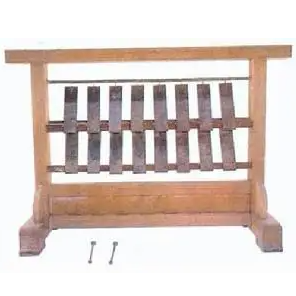The shape and structure of the square ring
Ancient Chinese percussion instruments, used in court Yan music. Appeared in the Liang Dynasty (502-557) of the Northern and Southern Dynasties.
Fangxiang is made up of sixteen rectangular iron, copper or jade pieces of the same size, with different pitches of different thicknesses, suspended in upper and lower layers, and struck with a small hammer. In the Song Dynasty, Fang Xiang was less and less used. Now it is only used occasionally in the ensemble of ancient music by the Jinyu Qin Society in Shanghai, and it is on the verge of being lost.
At the end of the 1970s, the Shanghai National Orchestra cooperated with the Shanghai National Musical Instrument Factory No. 1 to successfully develop a new type of Fangxiang based on the reference to ancient documents and the only remaining Fangxiang (made of wrought iron on the sounding plate). It has a 51-tone square sound, which can be played solo, in ensemble, or accompanied by songs and dances. It has been officially included in the national orchestra. Play the body music instrument. The ancient Chinese percussion instrument is a metal plate piano. It began in the Liang Dynasty (502-557) of the Southern and Northern Dynasties. "Old Tang Book Music Records" contains: "There is a copper chime in the beam, which covers the square ring. The square ring is made of iron. It is built eight inches, two inches wide, and the top and bottom of the circle are like a chime without setting up a business. (The industry refers to the large version on the horizontal wooden shelf). Lean on the shelf to replace the bell." In the Tang Dynasty, Fang Xiang was used in court Yan music.

Song and Chen's "Book of Music" is painted with the image of a square sound. It is composed of 16 rectangular copper plates (or iron plates) of the same size, which are divided into upper and lower rows and are suspended on a special wooden frame by ropes, and are struck with a small hammer. The rhythm sequence is as follows: from left to right in the lower row are Huang Zhong, Taicu, Guxi, Zhonglu, Ruibin, Lin Zhong, Nanlu, Wushe; upper row from right to left are Ying Zhong, Huang Zhongzhi Qing, Taicuo Zhiqing, Guxi Zhiqing, Zhonglu Zhiqing, Dalu, Yize, Jiazhong, twelve rhythms are prepared, and four clear voices (four high octaves) are attached. In the Southern Song Dynasty Zhou Mi's "Wulin Old Story", Fang Xiang once had solo pieces "Xichun", "Jadejing Spring Slow" and "Ling Divine Comedy" with zheng and pipa. There are many descriptions of Fang Xiang and its performance skills in Tang and Song poems, indicating that Fang Xiang was popular for a while in the Tang and Song Dynasties. Song later used less and less. In the Ming and Qing Dynasties, it was still used in court music, but it has been lost among the people. After the founding of the People's Republic of China, the musical instrument development department trial-produced a new type of square sound, using 43 rectangular steel plates as the sound board, with a prominent triangular sound point on the back. Each soundboard corresponds to a resonance tube, which is divided into two rows and arranged according to the piano keyboard. The sound is plump and melodious, and has been tried in Chinese folk bands.
In ancient times, Fangxiang was mostly composed of jade slices and iron plates, which were hung in two layers, and the pitch was determined by thickness and struck with a small hammer.
At the end of the 1970s, the Shanghai National Orchestra cooperated with the Shanghai National Musical Instrument Factory No. 1 to develop a new type of Fang Xiang based on the reference to ancient documents and the only remaining Fang Xiang (made of wrought iron with a sounding board). The sound board is made of 60# steel plate, the top of the sound board is rectangular, and the back has a prominent triangular sound point. The whole soundboard is composed of 43 soundboards, which are divided into two rows and arranged on a metal frame in a heptatonic sequence. An aluminum resonator is installed under each soundboard. There is a damping device on the piano frame. The height of the entire piano surface can be adjusted, and the angle of the piano surface can be adjusted within a range of 90 degrees, which can be played horizontally or played vertically like a chime and chime. Sound range (g1 ~ g4).
In the early 1980s, it was made into a 51-tone square sound. The soundboard adopts the twelve-equal-tempered "two-tone arrangement method". The above is the (#C) scale, and the following is the C major scale. ). The main frame on which the soundboard is placed can be lifted and rotated, which is convenient for playing horizontally or vertically, and is provided with a damping device and a resonance tube.
The sound of the new square ring is plump and pleasant, the high-pitched tone is crisp and bright, like a silver bell; the mid-range tone is sonorous and gorgeous; the low-pitched tone is thick and deep, like a bell. The new Fang Xiang is good at playing arpeggios and various rhythmic decomposition chords. Playing the melody or sub-melody with octave unison has a solemn and simple feeling, and playing cheerful and smooth music is more expressive. Can be used for large national orchestras and various performance forms. In the instrumental ensemble "Xiaoxiang Shuiyun", "The Moon is High", "Neon Clothes", the Erhu Concerto "The Great Wall Capriccio", the Erhu Ballad "Farewell to the Newlyweds" and the flute solo "Autumn Lake Moonlight" and vocal accompaniment, the new Fang Xiang has a good artistic effect.
 渝公网安备 50010702504639号
渝公网安备 50010702504639号